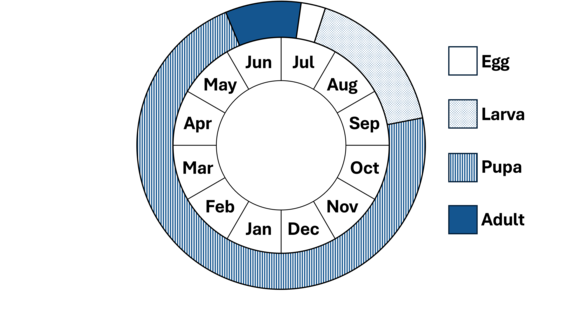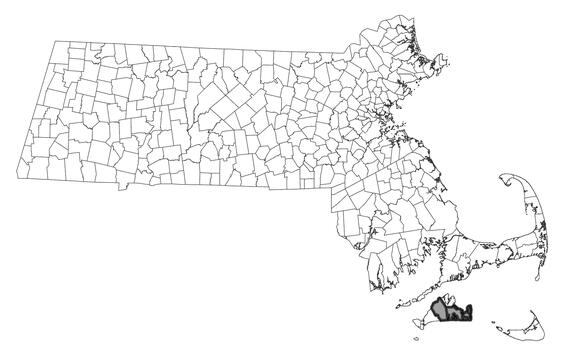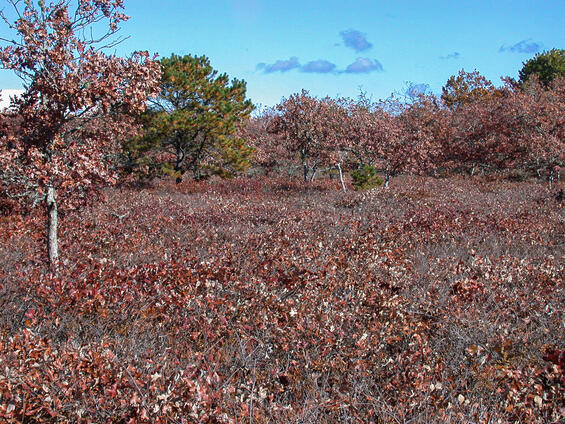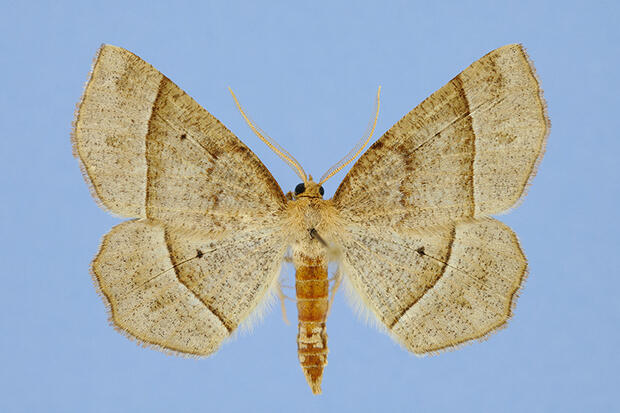- Scientific name: Metarranthis apiciaria
- Species of Greatest Conservation Need (MA State Wildlife Action Plan)
- Endangered (MA Endangered Species Act)
Description
The barrens metarranthis (Metarranthis apiciaria) is a geometrid moth with a wingspan of 29-38 mm (1.1-1.5 in) (Rupert 1943). Both the forewing and hind wing are brown proximal to the postmedial line, and paler tan distally. The wings are speckled with dark brown scales scattered throughout. On both the forewing and hind wing there may be faint patches of darker tan scales in the subterminal area, and there is a brown terminal line. On the forewing, the postmedial line is brown outlined with cream distally; it is very slightly curved, almost straight. The postmedial line on the hind wing is similar, but more curved. The brown antemedial line on the forewing is wavy but often obscure. The reniform and discal spots are reduced to small, solid, dark brown dots. As compared to the male, the forewing of the female is elongated and more pointed at the apex. In both sexes, the head, thorax, and abdomen are concolorous with the wings. The heath metarranthis (Metarranthis pilosaria) has a similar wing pattern, but overall, it is darker brown above, and on the underside it is bright orange, which is not the case with the barrens metarranthis.
Life cycle and behavior

In Massachusetts, adult barrens metarranthis moths fly from early June to early July. The larval host plants of this species have not been documented. Based on the life history of other Metarranthis species, eggs hatch a week or two after oviposition, and larvae grow slowly, not pupating until September. Pupae overwinter.
Distribution and abundance
Globally, there are only a few localities where this extremely rare moth is currently known to occur, including Martha’s Vineyard in Massachusetts, one site in Connecticut, one county in Illinois, and two counties in Indiana (Schweitzer et al. 2011).

Distribution in Massachusetts.
2000-2025
Based on records in the Natural Heritage Database.
Habitat
In Massachusetts, the barrens metarranthis inhabits open, shrubby areas within pitch pine-scrub oak barrens.
Healthy habitats are vital for supporting native wildlife and plants. Explore habitats and learn about conservation and restoration in Massachusetts.

Open, shrubby pitch pine-scrub oak barrens, habitat for the barrens metarranthis. Habitat managed by TNC at Medicine Lots Preserve.
Threats
The barrens metarranthis is threatened by habitat loss and fire suppression in its disturbance-dependent habitat, in particular pitch pine-scrub oak barrens. Other potential threats include introduced generalist parasitoids, aerial insecticide spraying, non-target herbicide application, and off-road vehicles. A warming climate may be detrimental to this species, as its range has a very narrow latitudinal extent. Northward range expansion may be possible, though this has not yet been documented.
Conservation
Land protection and habitat management are the primary conservation needs of this species in Massachusetts. In particular, coastal pitch pine-scrub oak barrens should be conserved, restored, and managed to maintain habitat for this species and the entire suite of rare and threatened species dependent on such habitats.
Survey and monitoring
In Massachusetts, the barrens metarranthis is known to be restricted to pitch pine-scrub oak barrens on Martha’s Vineyard. This population should be surveyed to document persistence at least once every 25 years; every 10 years is more desirable when practicable.
Management
Management of coastal pitch pine-scrub oak barrens benefits a suite of rare and threatened species, and habitat condition should be monitored and management adapted as needed. For the barrens metarranthis, open, shrubby barrens are of particular importance.
Research needs
The natural history and conservation needs of the barrens metarranthis are not well understood. Its life history is largely undocumented, and the larval host plants used in Massachusetts are not known. The future effects of a warming climate on this species are unpredictable and should be documented.
References
Rupert, L.R. 1943. A specific revision of the genus Metarranthis (Lepidoptera, Geometridae, Ennominae). Journal of the New York Entomological Society 51(3): 133-159.
Schweitzer, D.F., M.C. Minno, and D.L. Wagner. 2011. Rare, Declining, and Poorly Known Butterflies and Moths (Lepidoptera) of Forests and Woodlands in the Eastern United States. Forest Service, U.S. Dept. of Agriculture, Washington, DC. 517 pp.
Contact
| Date published: | March 7, 2025 |
|---|
